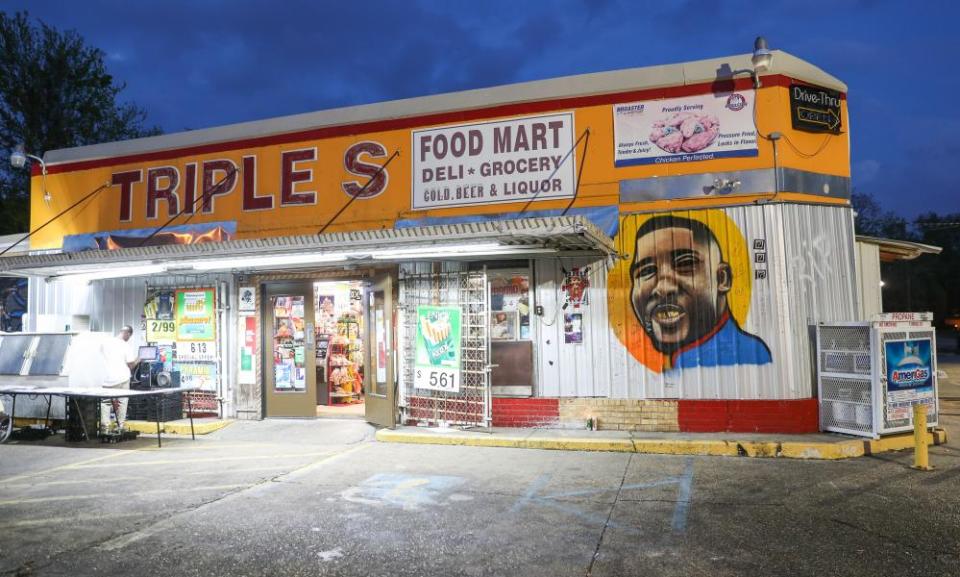Alton Sterling shooting: lack of charges prompts sadness but not surprise
Outside the Triple S in Baton Rouge, where Sterling was killed in July 2016, local residents say ‘we already knew the verdict’

At the Triple S mart in northern Baton Rouge, where in July 2016 Alton Sterling was killed by police officers, it was mostly business as usual on Tuesday.
Out front, Travis Hicks sold CDs under a portrait of Sterling while folks filtered in and out for lottery scratch tickets, Gatorade and chips. To the side, another vendor hawked boiled crawfish, $4 a pound.
The only discernible sign of anything unusual was a small group who had gathered in the wake of Louisiana attorney general Jeff Landry’s decision not to charge officers Blane Salamoni and Howie Lake over Sterling’s death. After a scuffle, Salamoni shot Sterling – who had been selling CDs – six times.
Some were saddened, others angry. Some wanted to show up to “do something positive”. None could register much in the way of surprise.
“I knew nothing was going to happen after what happened with the last one,” said Queen Shakur, referring to the federal decision not to indict the officers that was handed down last summer.
Authorities in Baton Rouge spent Monday night fortifying parts of the city, throwing up barricades and installing floodlights. They called in reinforcements from other parts of Louisiana, in case people took to the streets. But no demonstrations arose. Out front of police headquarters, as in the rest of city, all was quiet.
You gotta give the people something to shut them up … If you don’t give them that firing, this city just might go crazy
Rosalyn Scott
“The people wasn’t going to tear up the city because, let me tell you, the people, we already knew the verdict,” said Rosalyn Scott, another resident who had come to the Triple S.
Scott said she remained hopeful that at the very least Salamoni would be fired at the conclusion of an administrative review. But it was a hope that could only be expressed in the most cynical of terms.
“You’ve got to give the people something,” Scott said. “You didn’t give them a conviction, you didn’t give them an arrest, so you gotta give the people something to shut them up. If you don’t give them that firing, this city just might go crazy.”
The Baton Rouge police chief, Murphy Paul, said on Tuesday he expected the review to last about a week. Other officials have suggested an announcement could be made by Friday.
The investigation of Sterling’s death revealed that within seconds of arriving at the convenience store on 5 July 2016, in answer to an unidentified caller’s report of having been threatened with a gun, Salamoni approached the 37-year-old father of five with a gun pointed at his head.
Sterling was carrying a gun. The officers said they thought he had reached for it. The store owner said he had not. Use-of-force experts cited in Landry’s report were critical of the officers’ conduct, though they concluded that the shooting was “reasonable”.
The silence that greeted Landry’s report may not only have been the product of fatalist discouragement. It may have been tactical, too.
Shaena Johnson, an organizer with Astraea LGBTQ Racial Justice Fund, told the Guardian a group of young activists had asked her to tell media the lack of visible protest was intentional, and that plans for demonstrations were still in the works.
“They don’t want the national activists to come in and steal their light so that’s why they’re doing it the way they’re doing it,” Johnson said.
Many young activists, she said, were frustrated by the way out-of-town figures with large national followings showed up in the city to protest against Sterling’s death and received an outsized share of the media’s attention. The arrest of well-known protester DeRay McKesson made headlines nationwide. More than 200 people, Scott among them, were jailed in total.
Johnson said the young activists were spreading messages by word of mouth rather than flyers or social-media posts.
“There is a strategy,” she said. “The young folks are active and they are moving. They are the ones that were moving last time. They just didn’t get credit for it.”
This article was amended on 28 March 2018 to correct that Shaena Johnson works for Astraea LGBTQ Racial Justice Fund and is no longer at Empower Baton Rouge.

